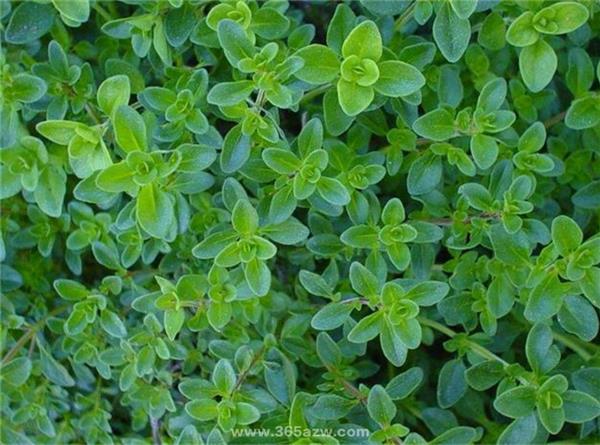Planting method of thyme
Thyme has a refreshing fragrance and a good name of "fragrance drifting for a hundred miles". The thyme plant is still small and the leaves are small, but the aroma is pungent, especially when it is in bloom. Today, I would like to introduce the planting method of thyme.
What kind of plant is thyme
Thyme is a perennial plant native to the Mediterranean region and is often used as a spice and medicine. Thyme grows mainly in tropical climates, and annual thyme is also found in temperate regions. The plant height of thyme is 1.2-3.6 meters, and there are about 60 varieties, including wild thyme and lemon-scented thyme.

Breeding method of thyme
Temperature: thyme likes warm climate, and the most suitable temperature for growth is 20-25 ℃. More cold-resistant, avoid high temperature and high humidity. In the environment of high temperature and humidity, thyme will grow weak and rot easily. Thyme is suitable for cultivation in cold areas, need to be raised in cool places in summer, and need to spray water and strengthen ventilation to lower the temperature.
Lighting: thyme likes plenty of sunshine, which will cause thyme to grow when there is not enough light. However, when the sun is strong in summer, proper shading is needed to avoid burning the branches and leaves.
Watering: thyme leaves are slightly fleshy, slightly resistant to drought and avoid waterlogging. Too wet basin soil will lead to poor growth of thyme roots, branches and leaves, and even lead to rotten roots and even plant death. The watering of thyme during the growth period should be mastered "do not dry, do not water,
The watering principle of "watering thoroughly". It is necessary to prevent the basin soil from getting too wet at high temperature in summer and control watering in winter to keep the basin soil relatively dry.
Fertilization: thyme grows slowly and does not need too much fertilizer. When the growth is exuberant in spring and autumn, rarefied fertilizer can be applied once a month. For thyme species with striped leaves, a combination of phosphorus and potassium fertilizer should be applied to brighten the color of the stripes. Fertilizer should be stopped in summer and winter, especially the growth of plants is weak in summer, and fertilization can easily lead to the death of rotten roots.
Pruning: thyme seedlings should be coring to promote branching and form a dense plant shape. Usually can be combined with pruning, cutting branches and leaves for use. Pruning messy branches and leaves to keep the plant beautiful, and conducive to ventilation and light. When pruning, you should be careful not to cut too low and hurt the woody stem, otherwise it will affect the sprouting power of the new buds of thyme.

Turn the basin: thyme usually needs to turn the basin once every 2 years or so, and replace it with neutral or alkaline soil with good drainage. The soil of potted thyme can be prepared with rotten leaf soil, peat soil and other materials, and about 20% perlite, rice chaff ash, coarse sand and other well-drained materials are added.
The breeding mode of thyme
The main propagation methods of thyme are seed propagation, cuttage propagation and ramet propagation.
Sowing and reproduction
Sowing and raising seedlings from March to April in spring. As the thyme seeds are small, the seedling ground must be carefully prepared, and the soil must be fine and flat, then slightly suppressed, watered and sowed, then covered with a thin layer of fine soil and covered with plastic film to keep warm and moisturizing. After 10-12 days of emergence, the temperature is timely uncovered. Attention should be paid to keeping the soil moist and weeding at the seedling stage. When the seedling height is 10-15 cm, it can be planted in the field directly according to the row and plant spacing of (30-45) cm × (25-30) cm, and watered after planting.
Cuttage propagation
The cuttings are very easy to root and propagate. In order to achieve the same quality in mass production, the cuttings with 3-5 nodes and about 5cm with apical buds can survive, but the rooting speed is slow and the root groups are few. When inserting it, it should be inserted into a paper tube seedling plate with a diameter of 2cm, so as to facilitate transplantation after survival. The striping and split method make the branches touch the ground and grow roots automatically, and the direct cutting is an independent plant, which is more suitable for home gardening growers.

Ramet propagation
Select more than 3-year-old plants, dig out the mother plants with roots in late March or early April, and then divide them into 4-6 parts according to the size of the clumps. Each clump should have 4-5 buds before planting. In addition, there is clustering breeding. During the growth period, the stolon was cut off and then transplanted.
Related
- Wuhan Hospital Iron Tree Blooming Result Was Instantly Frightened by the Gardener Master
- Which variety of camellia is the most fragrant and best? Which one do you like best?
- What is the small blue coat, the breeding methods and matters needing attention of the succulent plant
- Dormancy time and maintenance management of succulent plants during dormancy
- Minas succulent how to raise, Minas succulent plant pictures
- What are the varieties of winter succulent plants
- How to raise succulent plants in twelve rolls? let's take a look at some experience of breeding twelve rolls.
- Attention should be paid to water control for succulent plants during dormant period (winter and summer)
- Watering experience of twelve rolls of succulent plants
- Techniques for fertilizing succulent plants. An article will let you know how to fertilize succulent plants.



